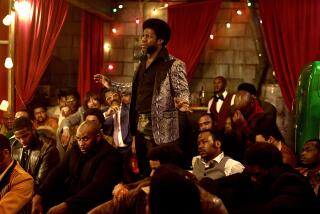Joe Frazier, not Muhammad Ali, gets the center ring in HBO’s ‘Thrilla in Manila’
- Share via
Smokin’ Joe is on the phone and upside my head, joking, singing and jawing once again about the fight of the decade, of the century, some would say of all time: the so-called “Thrilla in Manila.”
Justifiable or not, hyperbole was the order of the day on Oct. 1, 1975, when Joe Frazier climbed into the ring with Muhammad Ali for the third and final of their legendary bouts, in Araneta Coliseum in the sultry Philippines capital (the fight took place in the morning to accommodate live TV feeds for overseas audiences). Their epic confrontation is the subject of “Thrilla in Manila,” a HBO documentary that will debut tonight and be reshown on several subsequent dates.
“I really didn’t watch the fight because I didn’t like the way it finished,” Frazier replies when asked why he’d never bothered to view the bout before HBO’s crew asked him to, so that they could film his three-decade-delayed reaction.
Frazier wasn’t alone in that sentiment.
The furiously contested slugfest between Ali, the kinetic boxer, and Frazier, the dogged slugger with the withering left hook, ended with both men brutally battered. Frazier never forgave his trainer and cornerman, Eddie Futch, for stopping the fight before the 15th round, while Frazier fumed on his stool, one of his eyes closed from swelling. Ali, meanwhile, nearly had his hips lock up due to the punishment that Frazier was inflicting on his adversary’s organs.
Their rivalry was fueled by Frazier’s feeling that Ali had repeatedly insulted and mocked him, even after Frazier had come to Ali’s defense when Ali was forced to give up his championship belt after refusing to fight in the Vietnam War. At one point, Frazier even lent money to the down-and-out ex-champ.
Why did Frazier extend a hand to the man who later would ridicule him as an Uncle Tom and a “gorilla”?
“That’s what men is all about,” Frazier says. “That’s what M-E-N is all about. I’m trying to help the guy. He was down on his back. . . . I’m not like those new fighters where the man is down, you kick him around.”
Were he and Ali each other’s best opponents, Frazier is asked. “I would say yes,” comes the gravelly baritone in response. “We were the kind of guys that brought out the best in all the fights.”
Directed by John Dower and narrated by Liev Schreiber, “Thrilla in Manila” reconstructs events largely through Frazier’s eyes. “We felt that Joe’s story had not really properly been told,” Dower says.
The reason, Dower believes, is that the charismatic Ali’s made-for-television personality has dominated the historical record of his blood feud with Frazier, even though Ali memorably lost the first and most significant of their three showdowns, in Madison Square Garden on March 8, 1971, when both still were undefeated.
“When we set out to make this film we didn’t say, ‘Hey, let’s make a movie to trash Muhammad Ali,’ ” Dower says. Yet Dower felt that the Ali myth was so strong it had air-brushed out the darker aspects of Ali’s character and overshadowed Frazier’s achievements.
“Thrilla in Manila” documents the back story leading up to the bout: the polarizing nature of the 1971 fight, which split many Americans along racial lines, with blacks supporting the more avowedly anti-establishment Ali; the ironic reality that Frazier had a greater claim than Ali to blue-collar authenticity (Frazier was born in rural South Carolina, the son of a sharecropper who kept a moonshine still); and Ali’s attempt to whip up media attention over the Manila showdown by incessantly trash-talking Frazier.
“Thrilla in Manila” pummels away at the contradictions in Ali’s oversize personality. Although he converted to the Nation of Islam and presented himself as a scourge of white racism and hypocrisy, “Thrilla in Manila” includes interview footage of Ali joking about his appearance at a Ku Klux Klan rally, where he spoke against black-white intermarriage (a point on which the Klan’s and the Nation of Islam’s doctrines coincided).
That context sets up the movie’s suspenseful final section showing the match through archival footage. The intensity of the fighters and their ability to absorb body blows and still keep coming supplies all the drama that “Thrilla in Manila” needs.
“Both these guys are Ahab,” comments Jerry Izenberg of the Star-Ledger of Newark, N.J., one of several sports journalists who appear in the movie. The cast of characters also includes Imelda Marcos, the shopaholic widow of former Philippine strongman Ferdinand Marcos, who confesses on camera that she couldn’t bear to watch all of the gory encounter.
In concluding, “Thrilla in Manila” depicts the very different circumstances of the two ex-champs today. Ali, suffering from advanced Parkinson’s disease, remains an internationally beloved figure, while Frazier lives modestly but, by all evidence, exuberantly in Philadelphia, in a backroom of the building where he has owned a gym and trained young fighters for years.
“I don’t want to give you the impression that Joe is going around raving about Muhammad Ali every day,” Dower says. “He’s a very happy-go-lucky guy. He’s still out driving his cars incredibly fast, scary fast. He’s still chasing women.”
Indeed, Frazier says, he feels “like I’m 23 years old,” and he wants to have a little chat with President Obama about how to restore boxing to the prestige it enjoyed back in the day.
Oh, and one other thing. “I got the gym up for sale, man. Wanna buy it?”
More to Read
The biggest entertainment stories
Get our big stories about Hollywood, film, television, music, arts, culture and more right in your inbox as soon as they publish.
You may occasionally receive promotional content from the Los Angeles Times.











